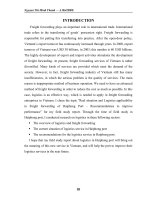Role Of R & D operations to improve competitiveness for Vietnam small and medium sized enterprises
Bạn đang xem bản rút gọn của tài liệu. Xem và tải ngay bản đầy đủ của tài liệu tại đây (357.35 KB, 8 trang )
ROLE OF R & D OPERATIONS TO IMPROVE COMPETITIVENESS
FOR VIETNAM SMALL AND MEDIUM SIZED ENTERPRISES
Dr. Nguyen Thi Thuy Quynh, Dr. Nguyen Thi Bich Lien
Email: ;
Faculty of Economics - Vinh University
Summary
Over the years, the Vietnam small and medium-sized enterprises was formed,
flourished and has confirmed its important role in the economy. However, the
competitiveness of Vietnam small and medium-sized enterprises is still very limited.
Therefore, in the coming time, Vietnam should have utility solutions to help to improve
competitiveness for these enterprises, which need special attention about the role of active
research and development (R & D).
Question
International economic integration is an objective tendency of every economy. For
Vietnam, a country currently in innovation and development process, international
integration is just the opportunity to expand the market, is both a major challenge for
Vietnam product quality and cost. The pressure of integration, enterprises need a
comprehensive plan including technological innovation, personnal training, upgrading
information systems and management, product quality assurance. So to see the important
role of R & D operation and finding appropriate solutions to the small and medium-sized
enterprises to enhance competitiveness based on R & D to meet the practical requirements.
1. Characteristics of R & D activity in Vietnam small and medium-sized
enterprises in Vietnam
According to reports about technological innovation in the industrial enterprises in
Vietnam (Institute for Economic Management Central, 2012), the enterprises‘ survey
indicated that they usually conduct one or several active R & D depending on financial
availability and business situation of their production as follows:
* Research to improve existing manufacturing processes: The improvement of
production processes include: improvements in technology, improvements in machinery,
production methods, alternative materials, ... here are the research activity now conduct
most. These can be explained by the investment in research activities to improve existing
manufacturing processes which are less expensive than investing in new machinery and
equipment, technological lines, while still having closed pole in improving product quality,
enhancing productivity, and improving products or new products.
* Products improved research and new products design: Type of activity rates are
higher now when conducting studies followed by product innovation and design. Product
enhancements conduct regularly and new products offering is an objective requirement for
businesses, especially goods consumer, garments manufacturing, cosmetics, paint and
973
shoes businesses, etc to diversify products to meet customers‘ demand for the change of
the external factors such as weather, environment, fashion and tastes, etc. These are the
reasons which businesses often conduct regular activities.
* To research and apply new production processes: With some enterprises, adoption
research of new manufacturing process are usually done with the property that the business
expansion would be rather than technological innovation. These means that new
investment in the technology chain in business, to enhance the output of existing products
or develop new products can be the same as category with the current product and can also
be a completely different items. At the adoption of new production processes can be
completely replace the equipment, machinery and technological factor, because these
require businesses to have invested enormously.
* Research and development: Research and implement the activities at the Vietnam
small and medium-sized enterprises to conduct production technological innovation. These
reflect the research and deployment capacity of the enterprise to be limited. In theory,
research and deployment operations of businesses including practicement research are to
renew the product manufacturing process; in the other hand, researchers create
technologies for the production or upgr����������������������������������������������������������������������������������������������������������������������������������������������������������������������������������������������������������������������������������������������������������������������������������������������������������������������������������������������������������������������������������������������������������������������������������������������������������������������������������������������������������������������������������������������������������������������������������������������������������������������������������������������������������������������������������������������������������������������������������������������������������������������������������������������������������������������������������������������������������������������������������������������������������������������������������������������������������������������������������������������������������������������������������������������������������������������������������������������������������������������������������������������������������������������������������������������������������������������������������������������������������������������������������������������������������������������������������������������������������������������������������������������������������������������������������������������������������������������������������������������������������������������������������������������������������������������������������������������������������������������������������������������������������������������������������������������������������������������������������������������������������������������������������������������������������������������������������������������������������������������������������������������������������������������������������������������������������������������������������������������������������������������������������������������������������������������������������������������������������������������������������������������������������������������������������������������������������������������������������������������������������������������������������������������������������������������������������������������������������������������������������������������������������������������������������������������������������������������������������������������������������������������������������������������������������������������������������������������������������������������������������������������������������������������������������������������������������������������������������������������������������������������������������������������������������������������������������������������������������������������������������������������������������������������������������������������������������������������������������������������������������������������������������������������������������������������������������������������������������������������������������������������������������������������������������������������������������������������������������������������������������������������������������������������������������������������������������������������������������������������������������������������������������������������������������������������������������������������������������������������������������������������������������������������������������������������������������������������������������������������������������������������������������������������������������������������������������������������������������������������������������������������������������������������������������������������������������������������������������������������������������������������������������������������������������������������������������������������������������������������������������������������������������������������������������������������������������������������������������������������������������������������������������������������������������������������������������������������������������������������������������������the business needs .
Currently, many different assessments show that R & D activity in Vietnam small
and medium-sized enterprises is very weak. Assessment of the results of the investigation
VCCI in 2013 is that nearly half of the businesses currently have no R & D to export
promotion. In addition, businesses in general and small and medium-sized enterprises in
particular are passive, refuses to link or go to R & D organizations. Regional links between
R & D institutions with manufacturers, and businesses in Vietnam today is very low. The
link between areas is weak due to many reasons, but in which there is the most reason is
no growth of the consultancy support services and technology market.
While the form of businesses counseling, supporting services thrive in developing
countries, the Vietnam services today is not yet fully aware of the importance. The national
legislation, statistical systems do not insist on this form. The important thing is that our
country lacking of the consulting services to help enterprises to conduct technological
innovation, promote the formation and development of scientific and technology market
and improve the businesses competitiveness .
Technical services related to the regular production activities of the enterprise
(maintenance services, maintenance and minor repairs of machinery and equipment)
usually conduct. For SOEs, their technical staff are trained regularly, even all over the nonstate enterprises. Moreover, the state-owned enterprises usually have a contract signed with
an R & D organization to perform complex technical consultancy. The private enterprise
applies only way to invite technical staff in large companies, through individual
agreements in technical issues.
The role of other forms of support services in Vietnam has been overlooked as one
of the factors that make it difficult for technological innovation in the small and mediumsized enterprises.
On assessing the effects of the factors limiting product innovation activities,
technological processes of enterprises, is shown by the results of the investigation about
techonological capacity in some industries. In the table, a scale was agreed as follows: 1:
does not matter; 2: very little significance; 3: mean; 4: very significant; 5: the nature of the
decision. The scores in the table is the average score on the results of businesses surveys in
each sector in 2007.
976
Table 3: To assess the impact of the factors limiting product innovation activities,
technological processes of enterprises
Affecting level
Affecting
factors
Electronics,
Seafood
Coffee
Agricultural
information,
Contruction
processing processing
engineering
telecommunications
A. Factors belongs to the business
Lack of
professional
qualified
human
resources
2,7
3,5
2,3
2,4
2,5
Lack of
information
technology
2,7
3,6
3,3
2,4
3,5
Lack of
outside
technical
support
services
2,3
3,1
3,1
2,6
3,5
Lack of
opportunities
for
cooperation
with the
outside
scientific and
technological
organizations
2,6
3,1
3,5
2,5
3,2
Difficult to
monitor the
cost of
innovation
1,8
1,8
1,9
2,1
2,2
Conservative
and fear
innovation
thinking of
business
2,1
1,6
1,9
1,8
1,2
2,3
2,5
2,3
B. Other factors
Risk
1,9
2,0
977
Affecting level
Affecting
factors
Electronics,
Seafood
Coffee
Agricultural
information,
Contruction
processing processing
engineering
telecommunications
aversion, and
waste of
renovation
money
Lack of
appropriate
funding
3,1
3,7
4,1
3,5
4,9
The payback
period for
renewal is
too long
3,0
3,1
3,1
3,1
3,7
Lack of the
opportunity
to interact
with new
technology
2,2
3,3
3,4
2,6
3,4
Fear of
innovation is
easy to
imitate
2,4
-
-
1,8
2,3
Legal
environment
is not
favorable
3,2
2,9
3,6
2,6
2,6
Tax regime
does not
encourage
innovation
4,0
3,4
4,0
2,7
3,4
exchange
goods
enjoying
psychology
of the
customer
3,1
1,1
-
2,4
3,1
Source : Report of the survey results about the level and technological capabilities
in some economic and technical sectors of Vietnam ( NISTPASS.2014)
978
It can be seen clearly in the context of international economic integration today, the
Vietnam small and medium-sized enterprises is still difficult in many aspects, especially in
technology, project management, human resources, investment capital technological
innovation, information technology, marketing and support services.
From the study of international experience shows that even if held under what form of
R & D in every business whose main task is working to create new products, the product is
competitive to meet market demand and implement the business development strategy.
However, it is precisely because of the imposition of duties is quite narrow that many R & D
enterprises, particularly in the case of businesses with medium-sized and small have failed to
fulfill the functions required of a R & D enterprises as such, leading to restrict, confine within
the framework of traditional products, waste resources and other business resources.
Worldwide, R & D functions in the enterprise is not only limited to the launch of
new products. A professional R & D department in an enterprise often extended and one or
more of the following activities:
* Product R & D: this is R & D functions purely in terms of the product to give
birth to the new product design, materials, properties and uses. For example, studies about
fish sauce made from salmon, the seasoning made from seaweed or herbal tea bottle,etc.
Enterprises to implement the R & D typically focuses more on product formulation, the
section, texture, color, flavor, style. In addition, R & D products also include research to
improve and enhance the products available quality.
Packaging R & D: in addition to R & D of new products, for some enterprises,
especially enterprises in the field of manufacturing and trading, R & D also has the
function of research and application of a new type of packaging material. Such a business
in the industry launched the bottled green tea products, is filling at high temperature,
required to have a plastic bottle made of heat-resistant material without being deformed,
non-toxic. R & D department of the enterprise researches to produce a material suitable for
the most appropriate cost for this new product.
The study of packaging products plays a huge role in the success of the consumer
products. Actually, sometimes just changing the packaging material, while keeping component
materials, quality and quantity of products inside, the consumption of the product would have
increased several times. Packaging for products instant noodles in Vietnam today is an
example in this case. When switching from paper packaging to plastic packaging, the products
of the enterprise instant noodles Vietnam's capital budget position, was able to fairly compete
with foreign products, though the quality inside have not changed much.
* Technology R & D: research activities, seeking production technology,
optimization process to get their product quality and cost optimization is one of the
important functions of R & D. For example, natural fermentation technology differs by
acid hydrolysis technology in the production of soy sauce.
* Process R & D: The nature of this function is to study, identify the production,
processing, assembly, operation, coordination. Its performance give high practical effect to
979
the enterprise. Typically for this activity is to improve the research and development of
production processes (for products), processes serving (for services), operating procedures
(for machinery). This activity can be considered R & D "software" of the product, other than
the "hardware" is material, formulation, packaging. In fact, the work of R & D "software" is
often overlooked or ignored, while efficiently bringing even higher than the "hardware". In
particular, for the type of service, research and development processes meant to serve a very
important, if not the decision in the success or failure of this kind of service.
In addition, to implement its mandate, R & D in the business can not help but focus
on a process of scientific truth. It's reasonable for R & D, are usually placed for a name that
so obviously "R & D process." This process defines the sequence of steps in R & D,
described the collaboration between the R & D with other business parts such as
marketing, production, quality control, finance from the receipt of the request, research,
analyzes from pilot production to mass production.
Thus, R & D activities in the business not only the limits of pure and rigid on target
launched new products or services. With this understanding, the function of R & D
department will be expanded, the expansion of the scope of R & D for business take
advantage of resources and cost savings.
References
1. The Government (2009), Decree No. 56/2009 / ND-CP dated 30/6/2009 of the
Government on development assistance to small and medium-sized enterprises
2. Vu Cao Dam, "Innovating financial mechanisms and policies for R & D
activities", document presented at the seminar "Innovation management mechanism R & D
activities", NISTPASS, 2003
3. Nguyen Huu Long, Necessary to understand the functions of R & D, the Saigon
Economic Times, 6/2009
4. GSO, "The situation of enterprises through the survey results in 2010, 2011,
2012, Publisher of Statistics, 2013
5. Hoang Van Tuyen, Synthesis Report "Look at the factors affecting R & D
activities of the company", NISTPASS, 2014
980









